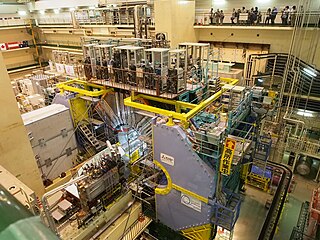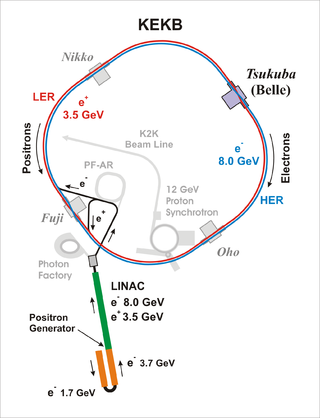
The charm quark, charmed quark, or c quark is an elementary particle of the second generation. It is the third-most massive quark, with a mass of 1.27±0.02 GeV/c2 and a charge of +2/3e. It carries charm, a quantum number. Charm quarks are found in various hadrons, such as the J/psi meson and the charmed baryons. There are also several bosons, including the W and Z bosons and the Higgs boson, that can decay into charm quarks.
In particle physics, the baryon number is a strictly conserved additive quantum number of a system. It is defined as

A tetraquark, in particle physics, is an exotic meson composed of four valence quarks. A tetraquark state has long been suspected to be allowed by quantum chromodynamics, the modern theory of strong interactions. A tetraquark state is an example of an exotic hadron which lies outside the conventional quark model classification. A number of different types of tetraquark have been observed.

In particle physics, quarkonium is a flavorless meson whose constituents are a heavy quark and its own antiquark, making it both a neutral particle and its own antiparticle. The name "quarkonium" is analogous to positronium, the bound state of electron and anti-electron. The particles are short-lived due to matter-antimatter annihilation.

Exotic hadrons are subatomic particles composed of quarks and gluons, but which – unlike "well-known" hadrons such as protons, neutrons and mesons – consist of more than three valence quarks. By contrast, "ordinary" hadrons contain just two or three quarks. Hadrons with explicit valence gluon content would also be considered exotic. In theory, there is no limit on the number of quarks in a hadron, as long as the hadron's color charge is white, or color-neutral.
CLEO was a general purpose particle detector at the Cornell Electron Storage Ring (CESR), and the name of the collaboration of physicists who operated the detector. The name CLEO is not an acronym; it is short for Cleopatra and was chosen to go with CESR. CESR was a particle accelerator designed to collide electrons and positrons at a center-of-mass energy of approximately 10 GeV. The energy of the accelerator was chosen before the first three bottom quark Upsilon resonances were discovered between 9.4 GeV and 10.4 GeV in 1977. The fourth Υ resonance, the Υ(4S), was slightly above the threshold for, and therefore ideal for the study of, B meson production.
In particle physics, a B-factory, or sometimes a beauty factory, is a particle collider experiment designed to produce and detect a large number of B mesons so that their properties and behavior can be measured with small statistical uncertainty. Tau leptons and D mesons are also copiously produced at B-factories.
The X(3872) is an exotic meson candidate with a mass of 3871.68 MeV/c2 which does not fit into the quark model because of its quantum numbers. It was first discovered in 2003 by the Belle experiment in Japan and later confirmed by several other experimental collaborations. Several theories have been proposed for its nature, such as a mesonic molecule or a diquark-antidiquark pair (tetraquark).
Light dark matter, in astronomy and cosmology, are dark matter weakly interacting massive particles (WIMPS) candidates with masses less than 1 GeV. These particles are heavier than warm dark matter and hot dark matter, but are lighter than the traditional forms of cold dark matter, such as Massive Compact Halo Objects (MACHOs). The Lee-Weinberg bound limits the mass of the favored dark matter candidate, WIMPs, that interact via the weak interaction to GeV. This bound arises as follows. The lower the mass of WIMPs is, the lower the annihilation cross section, which is of the order , where m is the WIMP mass and M the mass of the Z-boson. This means that low mass WIMPs, which would be abundantly produced in the early universe, freeze out much earlier and thus at a higher temperature, than higher mass WIMPs. This leads to a higher relic WIMP density. If the mass is lower than GeV the WIMP relic density would overclose the universe.

Modern searches for Lorentz violation are scientific studies that look for deviations from Lorentz invariance or symmetry, a set of fundamental frameworks that underpin modern science and fundamental physics in particular. These studies try to determine whether violations or exceptions might exist for well-known physical laws such as special relativity and CPT symmetry, as predicted by some variations of quantum gravity, string theory, and some alternatives to general relativity.
The Zc(3900) is a hadron, a type of subatomic particle made of quarks, believed to be the first tetraquark that has been observed experimentally. The discovery was made in 2013 by two independent research groups: one using the BES III detector at the Chinese Beijing Electron Positron Collider, the other being part of the Belle experiment group at the Japanese KEK particle physics laboratory.

Kim Sun-kee is a South Korean physicist. He is professor in Seoul National University and director of the Korea Invisible Mass Search. He was the first director of the Rare Isotope Science Project within the Institute for Basic Science and is a member of the Korean Academy of Science and Technology.

SuperKEKB is a particle collider located at KEK (High Energy Accelerator Research Organisation) in Tsukuba, Ibaraki Prefecture, Japan. SuperKEKB collides electrons with positrons at the centre-of-momentum energy close to the mass of the Υ(4S) resonance making it a second-generation B-factory for the Belle II experiment. The accelerator is an upgrade to the KEKB accelerator, providing approximately 40 times higher luminosity, due mostly to superconducting quadrupole focusing magnets. The accelerator achieved "first turns" (first circulation of electron and positron beams) in February 2016. First collisions occurred on 26 April 2018. At 20:34 on 15 June 2020, SuperKEKB achieved the world’s highest instantaneous luminosity for a colliding-beam accelerator, setting a record of 2.22×1034 cm−2s−1.
Terry Schalk is an American physicist currently Professor Emeritus at University of California, Santa Cruz and an Elected Fellow of the American Association for the Advancement of Science.
SooKyung Choi is a South Korean particle physicist at Gyeongsang National University. She is part of the Belle experiment and was the first to observe the X(3872) meson in 2003. She won the 2017 Ho-Am Prize in Science.
Michel Davier is a French physicist.

An electron-on-helium qubit is a quantum bit for which the orthonormal basis states |0⟩ and |1⟩ are defined by quantized motional states or alternatively the spin states of an electron trapped above the surface of liquid helium. The electron-on-helium qubit was proposed as the basic element for building quantum computers with electrons on helium by Platzman and Dykman in 1999.






















